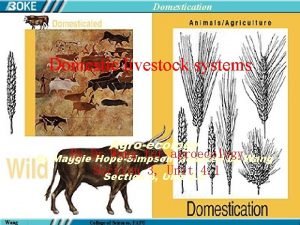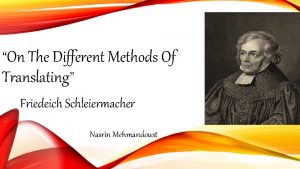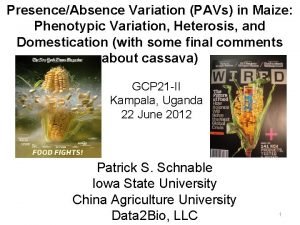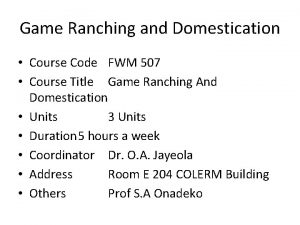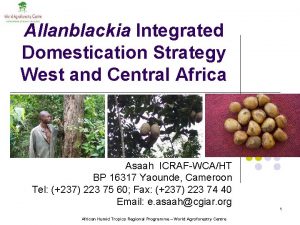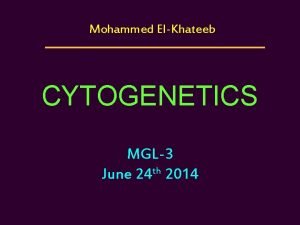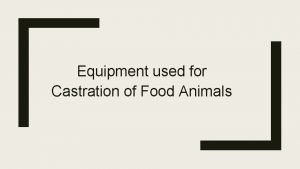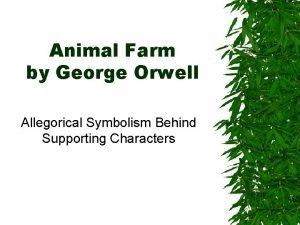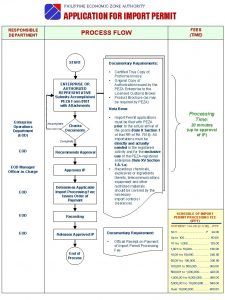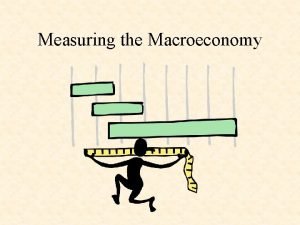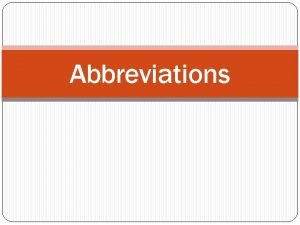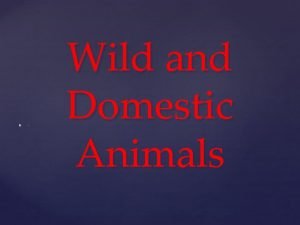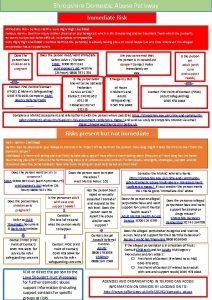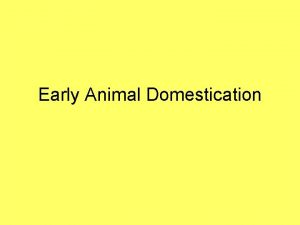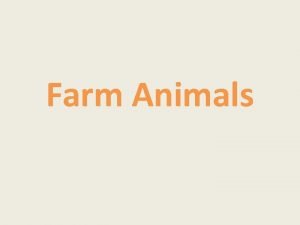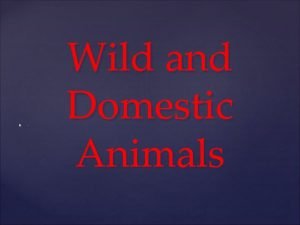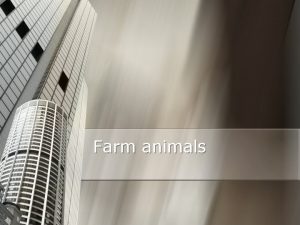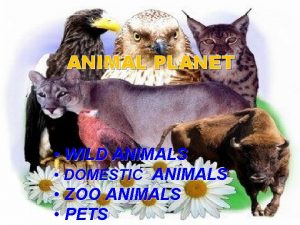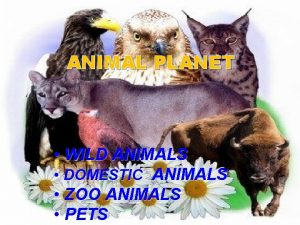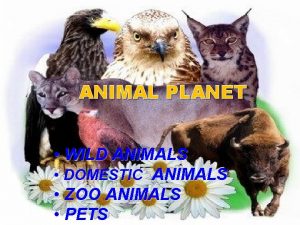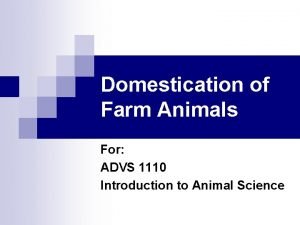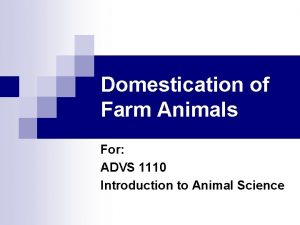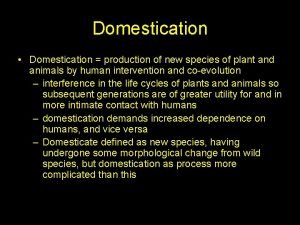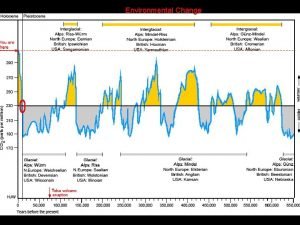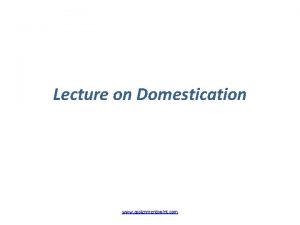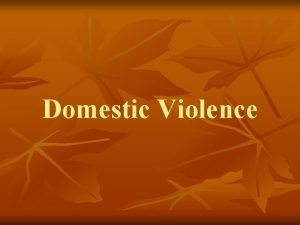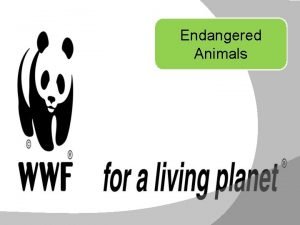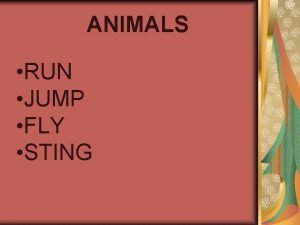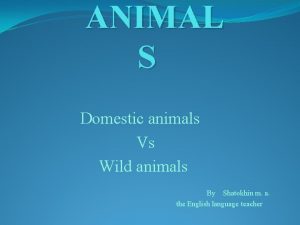Domestication of Farm Animals WHAT IS A DOMESTIC































- Slides: 31

Domestication of Farm Animals WHAT IS A DOMESTIC ANIMAL?

Brainstorm Time! • Get with your neighbors • What does domestication mean to you? • How do you define it? • Where do you think we would be today without domesticated livestock? • What differences would there be in our daily lives? • Present your answers to these questions to the class

Different Definitions http: //asci. uvm. edu/bramley/DOMESTIC. html "A domestic animal is one which has been selectively bred in captivity and thereby modified from its ancestors for use by humans who control the animal’s breeding and food supply"

http: //www. ag. usask. ca/exhibits/walkway/what/animdom. html Animals are domesticated when they are kept for clear purposes, their breeding is controlled, survival depends on humans, and they have acquired traits not found in the wild

Different Definitions taken from Modern Livestock & Poultry Production • Domesticate means to adapt the behavior of an animal to fit the needs of people • In simple terms, it means to tame

How did domestication begin? http: //asci. uvm. edu/bramley/DOMESTIC. html • Exactly how, when, and in what order the major livestock species became domesticated remains uncertain

Historical Link Between Animals and Humans • The lives of humans and animals have been interwoven for many thousands of years • Animals have been part of the human diet for many centuries and the use of animal skins provided humans protection from climatic extremes • Without the protection of animal skins humans would not have survived the ice age, 8000 - 9000 years ago

Historical Link Between Animals and Humans • Human culture and religion is abundant with animal symbolism • Examples include the sacredness of the cow among Hindus and the cat in ancient Egypt, and the role of reincarnation in some eastern religions • Human ancestors pursued animals for food and clothing for over a million years before any were domesticated

Historical Link Between Animals and Humans • As humans established communities, domestication of some wild species occurred • The majority of animal species can be tamed if reared from a young age; however, few species can be domesticated because certain characteristics are required of a species

Location and Estimated Dates of Domestication of Animals Species Date(B. C. ) Dog 10, 000 Location SW Asia, China, N. America Sheep 8, 000 SW Asia Goat 8, 000 SW Asia Pig 8, 000 SW Asia, China Donkey 4, 000 Egypt Horse 4, 000 Ukraine Chicken 3, 500 Central Asia Cattle 3, 000 Mesopotamia

Domestication of Farm Animals • Many species were domesticated and survive today in the ranges and grasslands of their wild ancestors • They have adapted to the ecological conditions of today

Sheep http: //www. ag. usask. ca/exhibits/walkway/what/animdom. html • Sheep were the first ruminants to be domesticated • Modern sheep are docile and dependent on humans, and much changed in physical appearance from their wild cousins • Sheep are known as Ovis aries

Goats http: //www. ansi. okstate. edu • Major contributor of modern goats is the Bezoar goat • Goats easily revert to feral or wild condition given a chance

Comparison of sheep and goats • Sheep • Stockier • Males have no beards • Males have no odor • Sheep are very domesticated; could not return readily to wild • Goats • Have shorter tails • Horns grow upward • Males have beards • Males have strong odor • More intelligent • Easily return to wild

Pigs http: //www. ansi. okstate. edu • All modern swine come from two wild stocks: • Sus scrofa • Sus vittatus

Pigs • The European and Chinese pig appear to have been separate domestications of different races of the same species • Chinese were first to tame pigs • Swine are more indicative of a settled farming community • The reason for this is simply because pigs are difficult to herd and move for long distances

Horses • Originated from Eohippus • Tamed later than any other farm animal • First animals were kept for meat and milk

Horses • Eohippus was not much larger than a cat and had four toes on its fore feet and three on its hind feet • Around 40 million years ago the one toed domestic horse evolved from Eohippus • Horse not considered a part of “farm livestock”

Chickensen • Domesticated from the jungle fowl of India • The most common domestic animal • Original chicken was Gallus gallus • Developed as a domesticated species in Indochina from the jungle fowl

Turkey • Derived from the wild turkey; a process begun by the Incas in Mexico • Domestic turkeys are larger and more docile than their wild ancestors • Turkey is the only important agricultural animal domesticated in the Americas

Turkey • Increased body weight has much reduced their ability to fly • Selection for white feathers was to improve the appearance of birds after killing and the removal of the feathers • Breeding has selected for birds with a rapid growth rate, an efficient conversion of feed to meat, and a high proportion of breast meat

Cattle • Modern domestic cattle evolved from a single early ancestor, the aurochs (Bos primigenius) • Wild ancestors were large, magnificent animals, temperamental and ferocious

Cattle • Remains of domesticated cattle found in Turkey • The last wild auroch was killed in Poland in the 17 th century • Last wild cattle were killed in eastern Europe in about 1630, although wild-type animals are kept in parks

Cattle • Cattle are smaller than their wild ancestors, and much more docile • Cattle were domesticated 10, 000 - 15, 000 years ago • Today the primigenius strain survives most strongly in Spanish fighting bulls, in Highland English Park cattle • The ancestor of domestic cattle is extinct (only farm animal that is this way)

Cattle • Cattle were brought to America by Columbus and Spaniards • All modern cattle come from 2 types: • Bos taurus • Bos indicus • Bos taurus; known as the European breeds • Bos indicus; the “eared” breeds or Brahman influence cattle

Biological Classification of Farm Animals All farm livestock Have a backbone Have live young Have eggs

Historical Functions of Animals • Skins/Furs used for clothing • Milk • Food • Development of societies • Transportation • Source of labor • Religious functions • Symbol of wealth • Companionship • Ritual functions • Sacrifices

Functions of Livestock Today • Converting feed into food • Conservation • Clothing • Stabilize farm economy • Power • Concentrate bulky feeds • Recreation • By-products

Importance of Livestock to the Overall scheme of Agriculture Of the total agricultural profits in the US, 52% comes from the livestock industry

Summarization • Domestication began about 12, 000 years ago • A domestic animal is tame • The turkey is the only animal that has been domesticated in America • Cattle have the only ancestor that is extinct • All farm livestock have biological similarities • Animals have always been and still are important to the livelihood of humans and agriculture

References • http: //asci. uvm. edu/bramley/DOMESTIC. html • http: //www. ag. usask. ca/exhibits/walkway/what/animdom. ht ml • http: //www. ansi. okstate. edu/breeds • Modern Livestock & Poultry Production, Fifth Edition, Delmar Publishing
 Domestication of animals
Domestication of animals Schleiermacher on the different methods of translating
Schleiermacher on the different methods of translating Domestication
Domestication Domestication
Domestication Domestication
Domestication Chromosome number of domestic animals
Chromosome number of domestic animals Parasitic food chain
Parasitic food chain Animals that eat both plants and animals
Animals that eat both plants and animals Https://a-z-animals.com
Https://a-z-animals.com Are bears producers or consumers
Are bears producers or consumers Equipment used for castration
Equipment used for castration Difference between partial budget and complete budget
Difference between partial budget and complete budget Harmouns
Harmouns Who does mollie represent in animal farm
Who does mollie represent in animal farm Peza form 8106 sample
Peza form 8106 sample The three r's for stopping domestic violence
The three r's for stopping domestic violence 12th amendment
12th amendment Download winlink express
Download winlink express Types of airspace
Types of airspace Domestic tourism in ghana
Domestic tourism in ghana Introduction to domestic wiring
Introduction to domestic wiring Gdp formula
Gdp formula Domestic discipline examples
Domestic discipline examples Distinguish between gdp and gnp
Distinguish between gdp and gnp William h taft domestic policy
William h taft domestic policy Domestic short haired cat
Domestic short haired cat Hatshepsuts family
Hatshepsuts family Is horse a domestic animal
Is horse a domestic animal International vs domestic
International vs domestic Routine, universal screening for domestic violence means: *
Routine, universal screening for domestic violence means: * Freight types
Freight types Shropshire domestic abuse service
Shropshire domestic abuse service
